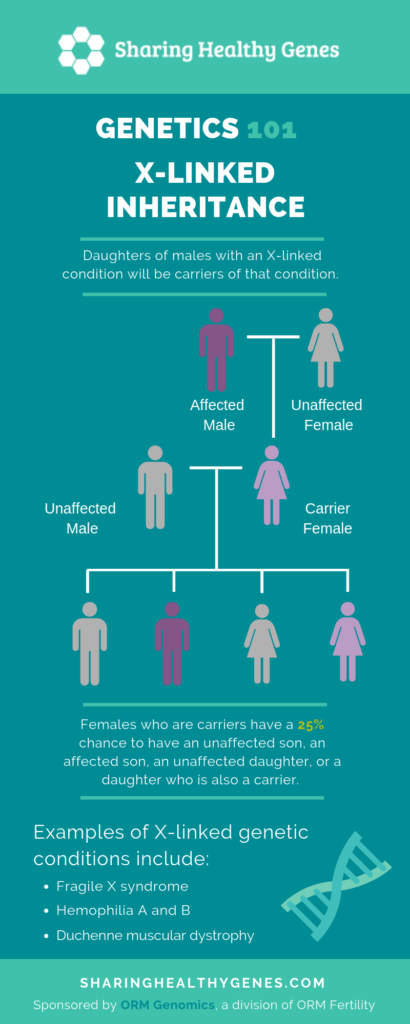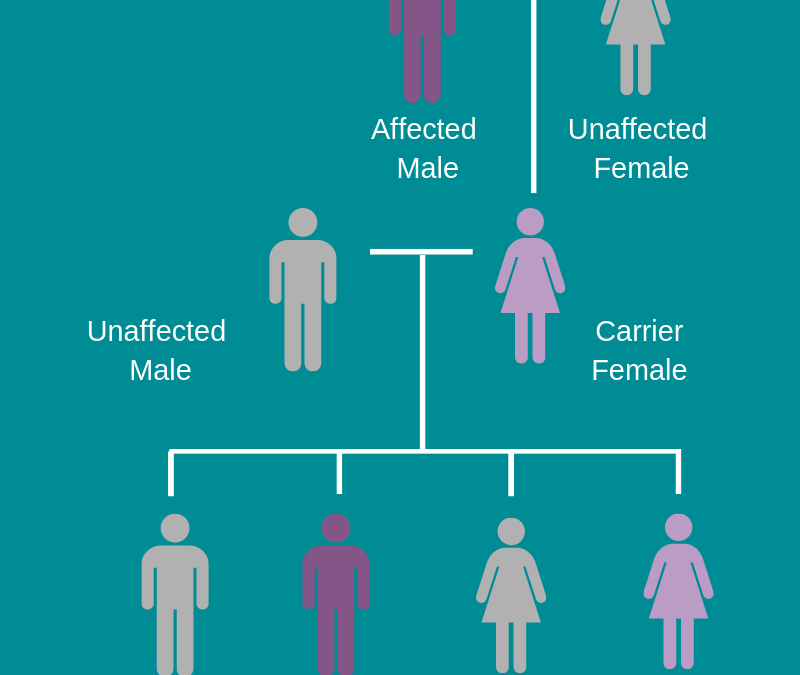Genetic diseases that run in families usually follow certain inheritance patterns. X-linked (sometimes called “sex-linked”) is one pattern of inheritance. It is called “X-linked” because the genes related to these types of diseases are found on the X chromosome, one of the sex chromosomes.
What are the sex chromosomes?
Genes are found in structures in our cells called chromosomes. The sex chromosomes, called the X and Y chromosome, determine our biological sex. Males inherit their X chromosome from their mothers and their Y chromosome from their fathers. Females inherit one X chromosome from each parent. Mutations or pathogenic variants in genes on these chromosomes can lead to symptoms of a genetic disease.
How does X-linked inheritance work? 
For biological females: A female is less likely to have symptoms of an X-linked genetic disease than a male, and the symptoms are usually milder. Females have two X chromosomes, so they have a “back-up” second X chromosome. When a female with an X-linked gene mutation has children, she has a 25% chance to have a son who inherits the mutation and is likely to show symptoms of the X-linked disease (see diagram for other possibilities).
For biological males: A male is more likely to have symptoms of an X-linked genetic disease than a female. Males have a single X chromosome, with no “back-up” second X chromosome. When a male with an X-linked gene mutation has children:
- All his daughters would inherit his mutation and be “carriers” (see more in section below)
- None of his sons would inherit his mutation since his sons get his Y chromosome
Can “carriers” of an X-linked disease have symptoms?
Females who carry an X-linked gene mutation are often called “carriers” (or “heterozygotes”). Carriers usually have milder symptoms of an X-linked disease, although their symptoms can be similar or even different from a male with an X-linked disease (see mention of fragile X syndrome below).
What are examples of X-linked diseases?
Hemophilia A is an inherited bleeding disorder related to the F8 gene on the X chromosome. It causes a range of symptoms, from easy bruising to life-threatening bleeding.
Fragile X syndrome is the most common inherited form of intellectual disability. Mutations in the FMR1 gene on the X chromosome cause the gene to be much larger than usual. Males with fragile X syndrome may have learning or behavior difficulties in childhood and other health issues as they get older. Females who are fragile X syndrome carriers can have symptoms, but they are often milder or different than those in males. For example, as fragile X syndrome carriers get older, they may develop premature ovarian insufficiency, which can include infertility and early menopause. This can become an important issue when it comes to family planning.
Can preimplantation genetic testing be done for X-linked diseases?
Preimplantation genetic testing (PGT) is commonly offered to women who are known carriers for or have a family history of an X-linked disease. While the exact number of IVF cycles using the technology is unknown, the list of diseases where PGT has been successfully performed continues to grow. Many factors play a role in whether or not parents decide to pursue PGT. Meeting with a genetic counselor before you become pregnant is the best next step to explore your risk to have a child with an X-linked disease and discuss the option of PGT.

Deepti is an independent consultant for Sharing Healthy Genes. She is a highly skilled writer and editor with medical communications and marketing experience, which blends with her 20+ years of clinical acumen as a certified genetic counselor in the U.S. and Canada. Deepti has an active consulting business and is an engaged member of the National Society of Genetic Counselors, most recently serving as a 2018-2020 Director at Large. In her downtime, you’ll find Deepti poring over cookbooks, facing down superhero quizzes from her sons, or writing about her family’s foodie gene on her blog.
